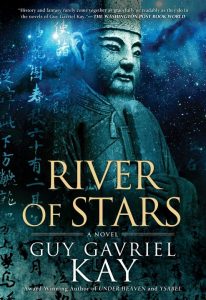 What I’ve read of Guy Gabriel Kay is long and winding (and enjoyable, provided I’m not in the mood for a breakneck thriller). Characters don’t follow a linear plot progression; events unfold. One technique of Kay’s impressed me when I read River of Stars. Although many people tell writers to show, not tell, the advice is sometimes difficult to follow. I find that examples are best. In the following scene, Kay’s character Wengao watches reactions when his friend Chen enters a room.
What I’ve read of Guy Gabriel Kay is long and winding (and enjoyable, provided I’m not in the mood for a breakneck thriller). Characters don’t follow a linear plot progression; events unfold. One technique of Kay’s impressed me when I read River of Stars. Although many people tell writers to show, not tell, the advice is sometimes difficult to follow. I find that examples are best. In the following scene, Kay’s character Wengao watches reactions when his friend Chen enters a room.
[E]very man with a connection to the literary or the political world knew Lu Chen–and his current fate. [Wengao] wondered for a moment if the daughter [Shan] would, then he saw the expression on her face.He felt a flicker of envy, like a long tongue from an old fire. She hadn’t looked at him that way. But he was old, really old. Could barely stand from a chair without wincing. Chen wasn’t a young man—his hair under the black felt hat and his narrow, neat beard were both greying—but he didn’t have knees that made walking an ambitious exercise. He was straight-backed, still a handsome young man, if thinner-faced than he ought to be, and seeming tired now, if you knew him and looked closely.
And he was the man who had written “Lines On the Cold Food Festival” and the “Red Cliff” poems, among others.
This excerpt shows how Shan reacts to Chen, even though there is very little text dedicated to her. It shows us (without telling) she is infatuated or even describing her features or reaction (despite common newbie misconceptions, showing doesn’t mean using flowery similes all the time). It shows by giving the reader a view of Wengao’s reaction to Shan’s infatuation. The paragraphs also do triple duty by characterizing Shan and Wengao and describing Chen’s physical appearance and renown as a poet. It shows Chen’s poems are famous and well received without telling you they are: by listing his poems as a reason why Shan, a well-read woman, would be smitten and by setting them off in a paragraph of their own, Kay skillfully conveys these poems’ cultural weight in the world of his novel.
Comments on Craft is a growing collection of examples of artful and well-constructed writing and storytelling and a discussion of why they work.




Leave a Reply